Royal Aircraft Factory B.E.2
| B.E.2 | |
|---|---|
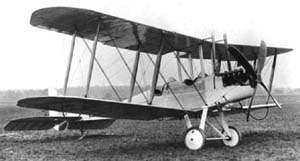 | |
| B.E.2c | |
| Role | Reconnaissance, light bomber, night fighter, trainer, coastal patrol aircraft |
| Manufacturer | Royal Aircraft Factory, Vickers, Bristol |
| Designer | Geoffrey de Havilland, E.T. Busk |
| First flight | 1 February 1912 |
| Introduction | 1912 (RFC) |
| Retired | 1919 (RAF) |
| Primary users | Royal Flying Corps/Royal Air Force Aviation Militaire Belge |
| Number built | ~ 3,500 |
| Variants | Royal Aircraft Factory B.E.9 Royal Aircraft Factory B.E.12 |
The Royal Aircraft Factory B.E.2 was a British single-engine tractor two-seat biplane designed and developed at the Royal Aircraft Factory. Most production aircraft were constructed under contract by various private companies, both established aircraft manufacturers and firms that had not previously built aircraft. Around 3,500 were manufactured in all.
Early versions of the B.E.2 entered squadron service with the Royal Flying Corps in 1912; the type continued to serve throughout the First World War. It was initially used as a front-line reconnaissance aircraft and light bomber; modified as a single-seater it proved effective as a night fighter, destroying several German airships.
By late 1915, the B.E.2 was proving inadequate in defending itself against German fighters such as the then new Fokker Eindecker, leading to increased losses during the period known as the Fokker Scourge. Although by now obsolete, it had to remain in front-line service while suitable replacements were designed, tested and brought into service. Following its belated withdrawal from operations, the type served in various second line capacities, seeing use as a trainer and communications aircraft, as well performing anti-submarine coastal patrol duties.
The B.E.2 has always been a subject of controversy, both at the time and in later historical assessment. From the B.E.2c variant on it had been carefully adapted to be "inherently stable", this feature was considered helpful in its artillery observation and aerial photography duties: most of which were assigned to the pilot, who was able to fly without constant attention to his flight controls. In spite of a tendency to swing on take off and a reputation for spinning, the type had a relatively low accident rate. The stability of the type was however achieved at the expense of heavy controls, making rapid manoeuvring difficult. The observer, often not carried because of the B.E.'s poor payload, occupied the front seat, where he had a limited field of fire for his gun.
Development
Background
The B.E.2 was one of the first fixed-wing aircraft to be designed at what was then called the Royal Balloon Factory (the organisation was formally renamed as the Royal Aircraft Factory on 26 April 1911).[1] The team responsible for its design came under the direction of British engineer Mervyn O'Gorman, the factory's superintendent. The B.E.2 designation was formulated in accordance with the system devised by O'Gorman, which classified aircraft by their layout: B.E. stood for Blériot Experimental, and was used for aircraft of tractor configuration (although in practice, all of the B.E. types were biplanes rather than the monoplanes typical of the Bleriot company).[2]
At first, the activities of the Factory were limited to the conduct of research into aerodynamics and aircraft design and the construction or design of actual aircraft was not officially sanctioned. O'Gorman got around this restriction by using the factory's responsibility for the repair and maintenance of aircraft belonging to the Royal Flying Corps; existing aircraft that needed major repairs were nominally reconstructed but often actually transformed into new designs, which generally retained few original elements apart from the engine.[3][4]
The first pair of B.E. aircraft were flown within two months of each other and had the same basic design, the work of Geoffrey de Havilland, who was at the time both the chief designer and the test pilot at the Balloon Factory.[5] The layout of these aircraft came to be seen as conventional, but when it first appeared this was not the case. Rather, in common with the contemporary Avro 500, the B.E.2 was one of the designs which established the tractor biplane as the dominant aircraft layout for a considerable time.[6] Written shortly following its first public appearance in early January 1912, aviation publication Flight commented of the aircraft that: "everything one could see of the machine was of singular interest".[7][4]
B.E.1

This was ostensibly a rebuild of a Voisin biplane, powered by a 60 hp (45 kW) water-cooled Wolseley engine; however, the B.E.1 used only the engine and radiator from this machine, the radiator being mounted between the front pair of cabane struts.
The B.E.1 was a two-bay tractor biplane - it had parallel-chord unstaggered wings with rounded ends, using wing warping for roll control. The wings were of unequal span: upper wingspan was 36 feet 7 1⁄2 inches (11.16 m) and lower 34 feet 11 1⁄2 inches (10.66 m).[8]
The fuselage was a rectangular section fabric-covered wire-braced structure, with the pilot seated aft, behind the wings and the observer in front, under the centre section. This arrangement was adopted so that the aircraft could be flown "solo" without affecting the aircraft's centre of gravity. Behind the pilot's position, a curved top decking extended aft to the tail, although the forward decking and cowling of later variants was not fitted at this stage.[9]
The aircraft's tail surfaces consisted of a half-oval horizontal stabiliser with a split elevator mounted above the upper longerons and an ovoid rudder hinged to the sternpost; there was no fixed vertical fin.[9] The main undercarriage consisted of a pair of skids each carried on an inverted V-strut at their rear and a single raked strut at the front: an axle carrying the wheels was bound to the skids by bungee cords and restrained by radius rods. A sprung tailskid was fitted, while the wings were also protected by semicircular skids located beneath the lower wings.[9]
The B.E.1 represented several firsts for aviation, including possibly being the first aeroplane to be outfitted with radio apparatus.[10]
It was first flown by de Havilland on 4 December 1911.[11] The aircraft was not flown again until 27 December, modified by the substitution of a Claudel carburettor in place of the original Wolseley, which allowed no throttle control. Other minor modifications were made over the following weeks: the undercarriage wheels were moved back 12 in (30.4 cm), the wings (which originally had no dihedral), were re-rigged to have 1° dihedral, and the propeller was cut down in an attempt to increase the engine speed.[8] Later, the Wolseley was replaced by a 60 hp (45 kW) air-cooled Renault.[12]
B.E.2
The B.E.2 was not so called because it was considered a separate type. At that time, the numbers allocated to factory aircraft are more properly regarded as constructor's numbers rather than type designations.[13][14] It was almost identical to the B.E.1, differing principally in being powered by a 60 hp (45 kW) air-cooled Renault V-8 engine and in having equal-span wings. Sometimes described as nominally a rebuild of an existing aircraft, either a Bristol Boxkite or a Breguet, it seems in fact to have been the first aeroplane built at the factory without the subterfuge of being a "reconstruction".[13] It first flew on 1 February 1912, again with de Havilland as the test pilot.[15] The Renault proved a much more satisfactory powerplant than the Wolseley fitted to the B.E.1, and performance was further improved when a 70 hp (52 kW) model was fitted in May that year.[16]
The B.E.2 was flown extensively at the Military Aeroplane Competition held on Salisbury Plain during August 1912. It was not allowed to formally compete in the trials since O'Gorman was one of the judges, but its performance was clearly superior to most of the aircraft competing: on 12 August 1912, the B.E.2 established a new British altitude record of 10,560 ft (3,219 m), while being flown by de Havilland and with Major F. H. Sykes on board as a passenger.[17][18]
Several other prototypes of the production B.E.2 series were produced, including the B.E.5 and the B.E.6. These essentially only differed from the B.E.2 in the powerplant, initially an ENV liquid cooled engine, and since both aircraft were eventually fitted with the standard 70 hp Renault, they became effectively equivalent to the production standard B.E.2.[19]
B.E.2a

The designation B.E.2a was assigned to the first production aircraft. The B.E.2a designation first appeared on a drawing dated 20 February 1912, which showed an aircraft with unequal span wings with slight dihedral.[18] These differed from preceding B.E.1 and B.E.2 in possessing a revised fuel system, in which the streamlined gravity tank below the centre section of the wing was moved to a position behind the engine. The main fuel tank remained under the observer's seat.[20]

Early production aircraft had unequal span wings, similar to those fitted on the B.E.1, and at first there was no decking between the pilot and observer's seats, although this was added later. Sandbag loading tests revealed that the safety margin of the rear spar was somewhat less than that of the front; to remedy this, a revised wing was designed with a deeper rear spar, and consequently a different aerofoil section. Later production aircraft also had equal-span wings. These modifications were retrofitted to the majority of the remaining earlier production aircraft.[20]
The first production order was placed with British manufacturing conglomerate Vickers;[21] shortly afterwards, a second order was issued for the type's production by the Bristol Aeroplane Company.[22] The first contractor-built B.E.2as appeared during the first weeks of 1913; during February of that year, at least two such aeroplanes were delivered to No.2 Squadron of the Royal Flying Corps, these were possibly the first examples of the type to enter service.[18]
B.E.2b
The B.E.2b which followed the original production standard benefitted from various improvements. It featured revised cockpit coamings, which afforded better protection from the elements, along with revised controls to both the elevator and rudder.[23] Some aircraft ordered as B.E.2bs were completed as B.E.2cs, and others were built with some of the B.E.2c modifications, such as sump cowlings and "V" undercarriages.[3]
At the outbreak of war, these early B.E.2s formed part of the equipment of the first three squadrons of the RFC to be sent to France. A B.E.2a of No.2 Squadron was the first aircraft of the Royal Flying Corps to arrive in France after the start of the First World War, on 26 August 1914.[3]
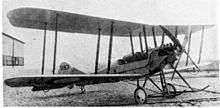
B.E.2c
The B.E.2c was a major redesign, the result of research by E.T. Busk intended to provide an inherently stable aeroplane. This was considered desirable to allow the crew's full attention to be devoted to reconnaissance duties. The first example, a converted B.E.2b, flew on 30 May 1914 and the type went into squadron service just before the outbreak of war.[24] Relatively large orders were placed for the new version, with deliveries of production aircraft starting in December 1914. During 1915, this model replaced the early B.E.2s in the squadrons in France.[25] The B.E.2c used the same fuselage as the B.E.2b, but was otherwise really a new type, being fitted with new wings of different planform with increased dihedral and forward stagger, and ailerons replaced the wing warping of the earlier models. The tailplane was also completely new, and a triangular fin was fitted to the rudder.[24]

After the first few aircraft, production machines were powered by a development of the Renault engine, the RAF 1a, and the twin skid undercarriage was replaced by a plain "V" undercarriage. A streamlined cowling to the sump was also fitted to later models, while a cut-out in the rear of the centre section marginally improved the observer's field of fire, as well as giving the pilot a better view forward over the wing. On later machines, the fin was enlarged to reduce the aircraft's tendency to swing on take-off and to improve spin recovery.[26]
B.E.2d
The B.E.2d was a dual control version of the aircraft. Being otherwise identical to the "c" variant, it was provided with full controls in the front cockpit as well as in the rear.[27] This modification meant that there was no longer room for the fuel tank under the observer's seat, which had to be replaced by a centre section gravity tank; in order to give the "d" a superior endurance this tank was unusually large, adding extra weight and drag that reduced the type's performance, particularly in the climb.[27] Most B.E.2ds were used as trainers, and the few used on operations by the RFC seem to have been flown from the normal (rear) pilots' seat.
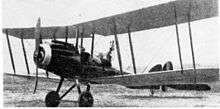
On the other hand, photographs of B.E.2ds supplied to Belgium make it clear that not only were these re-engined with Hispano engines, but at least some of them had the pilot and observer's seating positions reversed, giving the latter a much better field of fire for his gun(s). Some of the Belgian B.E.2cs were similarly modified, while at least one was fitted with a Scarff ring over the rear cockpit.
B.E.2e
During 1916, the "c" began to be superseded by the final version, the B.E.2e. This variant was again distinguished by completely new wings, braced by a single pair of interplane struts per side (as a "single-bay" biplane), and a set of shorter wingspan lower wing panels. The ailerons, on upper and lower wings, were joined by light struts. The tailplane was again a new unit – being smaller than that of the B.E.2c and d – and the larger, quadrant shaped vertical fin of the late B.E.2c became standard.[28]
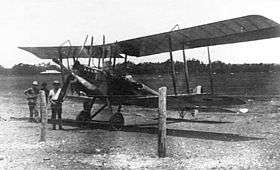
It was intended to fit a new, uprated version of the RAF 1 – the RAF 1b – but in the event this engine did not achieve production status, and the B.E.2e used the same engine as its predecessor, considerably reducing the expected improvement in performance.[29]
Many B.E.2c and B.E.2d aircraft still under construction when the new model entered production were completed with B.E.2e wings. To rationalise the supply of spare parts these aircraft were officially designated as the "B.E.2f" and "B.E.2g".[30]
About 3,500 B.E.2s were built by over 20 different manufacturers. An exact breakdown between the different models has never been produced, if only because so many B.E.2s were completed as later models than originally ordered.[31]
The B.E.9 and the B.E.12 were variants developed to provide the B.E.2 with an effective forward-firing armament. The B.E.12 (a single-seater) went into production and saw squadron service, however neither variant was ultimately a great success; both designs having been superseded by newer fighter aircraft by the time they were completed.[32][33]
Operational history
Prewar service
During the pre-war period, those B.E.2s that had reached service were primarily flown by No 2, No 4 and No 6 Squadrons,[34] who rapidly accumulated an unusually high number of flight hours on the type. Aviation author J.M. Bruce has commented that during this time, compared with their contemporaries, the early B.E.2s demonstrated a high standard of serviceability and reliability: as borne out by the squadrons' maintenance records.[34]
During this time, multiple long-distance flights were conducted using individual B.E.2s, many of these by No. 2. Squadron.[34] On 22 May 1913, Captain Longcroft flew his aircraft from Farnborough Airport to Montrose Aerodrome, covering the 550 mile distance in ten hours, 55 minutes, with two intermediary stops. On 19 August 1913, Longcroft repeated this trip using a B.E.2 outfitted with an additional fuel tank, lowering the journey time to seven hours, 40 minutes with only one stop midway.[34] Several improvements for the aircraft were developed during this time, including several different implementations of additional fuel tanks and alternative undercarriages, which were fitted on an experimental basis and helped the further development of the design.[35]
Western Front
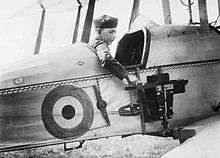
The early models of the B.E. 2 had already served in the RFC for two years prior to the outbreak of the Great War, and were among the aircraft that arrived with the British Expeditionary Force in France during 1914. Like all service aircraft of this period, they had been designed at a time when the qualities required by a warplane were largely a matter for conjecture and speculation, in the absence of any actual experience of the use of aircraft in warfare: at this stage all the combatants were still feeling their way and aerial combat, especially the need for reconnaissance aircraft to be able to defend themselves, was not widely anticipated. As a result, the B.E.2 was originally designed without any provision for armament.[36]
In the absence of any official policy regarding armament, more aggressive crews improvised their own.[37] While some flew entirely unarmed, or perhaps carried service revolvers or automatic pistols, others armed themselves with hand-wielded rifles or carbines as used by ground troops, or even fitted a Lewis gun. The performance of the early Renault powered models of the B.E. was degraded by any additional weight, and in any case the carriage of this weaponry proved of questionable effectiveness.[36]
It was still necessary for the observer to be located over the centre of gravity, in front of the pilot, to ensure fore and aft balance. In this awkward position, his view was poor, and the degree to which the he could handle a camera (or, later, a gun) was hampered by the struts and wires supporting the centre section of the top wing. In practice, the pilot of a B.E.2 almost always operated the camera, and the observer, when he was armed at all, had a rather poor field of fire to the rear, having, at best, to shoot back over his pilot's head.[38] Whenever bombs were to be carried, or maximum endurance was required, the observer would normally have to be left behind.[3]
Nonetheless, the B.E.2s were already in use as light bombers as well as for visual reconnaissance, an attack on Courtrai Railway station earning 2nd/Lt Rhodes-Moorhouse a posthumous Victoria Cross on 26 April 1915.[3][39] By this time, prewar aircraft were already disappearing from RFC service.
The type that replaced the B.E.2a and B.E.2b (as well as the assortment of other types in use at the time) in the reconnaissance squadrons of the RFC in 1915 was the B.E.2c, which had also been designed before the war. The most important difference in the new model was an improvement in stability – a genuinely useful characteristic, especially in aerial photographic work, using the primitive plate cameras of the time, with their relatively long exposures. Unfortunately, in this case, the stability was coupled with "heavy" controls and relatively poor manoeuvrability. A suitable engine was not available in sufficient quantities to replace the air-cooled Renault – the RAF 1a being essentially an uprated version of the French engine – so that the improvement in the B.E.2c's performance was less than startling.[3]
The vulnerability of the B.E.2c to fighter attack became plain in late 1915, with the advent of the Fokker Eindecker. This led the British press to disparagingly refer to the aircraft as being "Fokker Fodder", while German pilots also gave it the nickname of kaltes Fleisch ("cold meat"). British ace Albert Ball summed up B.E.2c as being "a bloody awful aeroplane". Unable to cope with such a primitive fighter as the Fokker E.I, it was virtually helpless against the newer German fighters of 1916–17. The aircraft's poor performance against the Fokker and the failure to improve the aircraft or replace it caused great controversy in England, with Noel Pemberton Billing attacking the B.E.2c and the Royal Aircraft Factory in the House of Commons on 21 March 1916, saying that RFC pilots in France were being "rather murdered than killed".[40]
This agitation prompted the setting up of two enquiries; one into the management of the Royal Aircraft Factory, and another into the high command of the Royal Flying Corps, the latter of which being headed by a judge. These reports largely cleared both Factory management and the RFC commanders responsible for ordering the B.E.2, but Mervyn O'Gorman was effectively dismissed as supervisor of the Factory by a "sideways promotion", while many of the most talented individuals amongst the factory's designers and engineers followed de Havilland into private industry.[40][41][42]
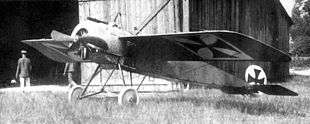
Once the threat from the Fokker monoplanes had been effectively contained by the introduction of a new generation of Allied fighters, such as the Airco D.H.2 and Nieuport 11, the rate of B.E.2c losses over the Western Front dropped to an acceptable level; official records indicate that during the second quarter of 1916, the B.E.2 actually had the lowest loss rates of all the major types then in use by the service.[43] Encouraged by this, the RFC took delivery of large numbers of the BE.2e, which promised improved performance, and combined the stability of the B.E.2c with rather "lighter" controls (which held the promise of better manoeuvrability).[44]
By the spring of 1917, however, conditions on the Western Front had changed again as a consequence of the German fighter squadrons having been re-equipped with better fighters, such as the Albatros D.III. It had been planned that by this time B.E.2s in front-line service would have been replaced by newer aircraft, such as the Royal Aircraft Factory R.E.8 and Armstrong Whitworth F.K.8, but delivery of these types was initially slower than hoped. This situation culminated in what became known as "Bloody April", with the RFC losing 60 B.E.2s during that month.[45]
An incident illustrating both the poor level of piloting skills with which new RFC pilots were sent to France in 1917 and the level of popularity of the B.E.2e on the Western Front at that time is recorded by Arthur Gould Lee, then a young RFC novice, in his book No Parachute. On 19 May 1917, six pilots, newly arrived in France and still to be allocated to a squadron, were each given a new B.E.2e to ferry between RFC depots at St Omer and Candas. One crashed in transit, three crashed on landing and one went missing (the pilot was killed). Lee, the pilot of the only aircraft to arrive safely, wrote in a letter to his wife:
- I felt rather a cad not crashing too because everyone is glad to see death-traps like Quirks written off, especially new ones.[46]
Fortunately, by this time, the B.E.2e was already being rapidly replaced on the Western Front by later types, but this was from several points of view more than a year too late.[30]
Night fighter
As early as 1915, the B.E.2c entered service as a pioneer night fighter, being used in attempts to intercept and destroy the German airship raiders. The interceptor version of the B.E.2c was flown as a single-seater, outfitted with an auxiliary fuel tank on the centre of gravity in the position of the observer's seat. After encountering an initial lack of success while using Ranken darts and small incendiary bombs to attack airships from above, a single Lewis gun was mounted to fire a mixture of explosive and incendiary ammunition upwards, at an angle of 45°, to attack the airship from below.[47][note 1]
The new tactic proved to be highly effective. On the night of 2–3 September 1916, a single B.E.2c was credited with the downing of SL 11, the first German airship to be shot down over Britain after over a year of night raids.[48] This feat led to the pilot, Captain William Leefe Robinson, being awarded a Victoria Cross and various cash prizes, totalling up to £3,500, that had been put up by a number of individuals.[49]
This was not an isolated victory; five more German airships were destroyed by Home Defence B.E.2c interceptors between October and December 1916.[47] As a consequence of these losses, the German Army's airship fleet ceased raids over England: German naval airship raiders of 1917 flew at higher altitudes to avoid interception, reducing their effectiveness. Daylight raids by heavier-than-air bombers were also planned.[50]
There were various efforts made and studies conducted for the purpose of improving the anti-Zeppelin capabilities of the B.E.2; perhaps the most elaborate of these was known as the Fiery Grapnel.[51] Developed by the Royal Aircraft Factory, the grapnel consisted of a two-inch long hollow steel shaft packed with an explosive charge and fitted with a sharp four-sided nose and metal plates that acted as fins; this would have been attached to a winch-mounted cable and carried by a single B.E.2.[51] It was intended for the aeroplane to approach a Zeppelin, after which the wire would be deployed and appropriate manoeuvring employed to strike the surface of the Zeppelin with it; the grapnel would bury itself into a gas bag and explode, causing significant and likely fatal damage to a Zeppelin. In practice, a direct hit would have been necessary, or the cable would quickly snap; it did not proceed beyond experiments and was abandoned, in part due to the emergence of more conventional and practical incendiary machine gun ammunition.[51]
The performance of the B.E.2 was inadequate to intercept airships flying at 15,000 feet much less the Gotha bombers that emerged during 1917, and its career as an effective home defence fighter was over.
Other fronts
While the majority of operational B.E.2s served on the Western Front, the type also saw limited use in other overseas theatres.[51] According to Bruce, at least one pair of B.E.2s were among the aircraft dispatched with No 3 Squadron for use in the Gallipoli Campaign. They were used to spot in support of naval bombardments, as well as being occasionally used to directly bomb ships and other targets.[52]
As early as 1914, some B.E.2as went to Australia, where they served as trainer aircraft for the nascent Australian Flying Corps at Point Cook, Victoria.[51] In a similar fashion, the type also was adopted at the Indian Flying School at Sitapur. At least one B.E.2 was dispatched to Egypt to reinforce friendly forces fighting in the Eastern Mediterranean; on 16 April 1915, this aircraft participated in the bombing of El Murra.[51]
Airship gondola
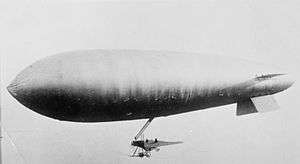
A number of B.E.2 fuselages were employed as makeshift gondolas for the hastily designed SS class "blimps", which were introduced into service by the Royal Naval Air Service for anti-submarine duties during March 1915. Later classes featured purpose-built gondolas.[53]
Withdrawal from combat
From 1917 onwards, the B.E.2 was generally withdrawn from both the front line and night fighter use.[36] The surviving examples continued in use for submarine spotting and as trainers throughout the rest of the conflict. In spite of the type's rather unresponsive controls, it was capable of executing comprehensive (if somewhat stately) aerobatics, and was by no means a bad trainer.[54]
On 19 February 1917, a B.E.2c was used to conduct the British Army's first aeromedical evacuation when it flew out the sole casualty of the raid on Bir el Hassana in the Sinai Peninsula. The man had a shattered ankle, and the 45-minute flight in the observer's seat spared him an agonizing multi-day journey by camel.[55]
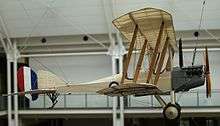
Post-war use
A B.E.2e was used to conduct the first flight across Australia, flying from Melbourne to Port Darwin. It was piloted by Captain H. N. Wrigley, accompanied by Sergeant A. W. Murphy. The 2,500 mi (4,000 km) journey, made between 16 November and 12 December 1919, involved a combined 46 hours of flying time.[56]
Another B.E.2e was one of the first two aircraft (the other was an Avro 504K) owned by the new Australian airline Qantas when it was founded in Queensland in 1920–1921.[57]
Survivors and reproductions
Surviving restored aircraft and reproductions are on display at several museums, including the Imperial War Museum, Duxford; the RAF Museum, Hendon; the Canada Aviation Museum, Ottawa; the Musée de l'Air et de l'Espace, Paris; the Militaire Luchtvaartmuseum, Soesterberg, Netherlands; United States Army Aviation Museum and the Norwegian Armed Forces Aircraft Collection at Oslo Airport, Gardermoen, Norway.
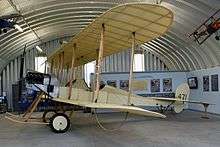
B.E.2f serial A1325 has been restored to airworthiness by The Vintage Aviator Ltd in New Zealand,[58] with an original RAF1A V8 engine, and made its debut at the Classic Fighters Omaka airshow in April, 2009. TVAL has also built several airworthy reproductions including c and f models, two of which are currently in the UK on loan to the WW1 Aviation Heritage Trust.
A flying B.E.2c replica (registered G-AWYI) was built by pilot and engineer Charles Boddington at Sywell, UK in 1969 for use in the film Biggles Sweeps the Skies. The production was cancelled, and Boddington was killed the following year in an air crash during filming of the movie Von Richthofen & Brown. The B.E.2c itself was badly damaged in a crash in the United States in 1977 but Boddington's son Matthew returned it to flying condition in 2011.[59]
The UK's latest non-flying reproduction was built at Boscombe Down, Wilts, completed around 2008 and is now displayed with the Boscombe Down Aviation Collection at Old Sarum.
A B.E.2a (early variant with unequal span wings) was built from the original plans and completed in February 2014. It is on display at the RAAF Museum, Point Cook, Victoria, Australia.
Volunteers at Montrose Air Station Heritage Centre, Angus, Scotland have built a full-size replica B.E.2a (No.471) from original plans and it is now on display. It has a precision-made replica Renault 70 hp engine.[60]
Variants
- B.E.1: Prototype – important pioneer tractor biplane. The first B.E.2 was virtually identical, except for the engine originally installed.
- B.E.5: Prototype, officially a rebuild of a Howard Wright biplane, powered by 60 hp (45 kW) ENV engine, otherwise similar to original B.E.2. First flight 27 June 1912. Rebuilt with Renault engine and effectively became a B.E.2.[61]
- B.E.6: Prototype, officially a rebuild of the Royal Aircraft Factory S.E.1. First flown 5 September 1912, powered by a 60 hp (45 kW) ENV engine like the B.E.5, but refitted with Renault before delivery to RFC later that month, as a B.E.2.[62]
- B.E.2a: Initial production version of B.E.2. Built in small numbers from late 1912 – still a standard type at the outbreak of war in late 1914
- B.E.2b: basically, the same as the "a" with higher sides to the cockpits; late examples (perhaps those completed after the B.E.2c went into production) used ailerons instead of wing warping and featured other "c" characteristics such as "V" undercarriages and engine sump cowlings.
- B.E.2c: extensively redesigned – really a new aeroplane.
- B.E.2d: essentially a "c" variant with dual controls, and a larger gravity fuel tank
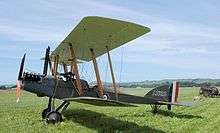
- B.E.2e: the final version, with new single-bay wings. Expected to be a great improvement on the "c", it was a major disappointment. Nicknamed the "Quirk".
- B.E.2f: B.E.2c with B.E.2e wings.
- B.E.2g: B.E.2d with B.E.2e wings.
- B.E.9: B.E.2c with a wooden box (called a "pulpit", somewhat like the French SPAD S.A) in front of the propeller for an observer/gunner's seat. It remained a prototype only.
- B.E.12: single-seat B.E.2c with a synchronised gun and more powerful engine. The B.E.12a had B.E.2e wings.
Operators
- Australian Flying Corps
- No. 1 Squadron AFC in Egypt and Palestine[63]
- No. 4 Squadron AFC operated a single B.E.2e for training[63]
- No. 7 (Training) Squadron AFC in the United Kingdom[63]
- Mesopotamian Half Flight
- Central Flying School at Point Cook, Victoria[64]
- Royal Netherlands Air Force - One aircraft only.
- Union Defence Force / South African Air Force
- Serial numbers A3109 and A3110 build by Wolseley Motors Limited and nicknamed Rio de Janeiro Britons Nos. 1 & 2 were two of the first aircraft used by the South African Air Force

- Royal Naval Air Service
- No. 1 Wing (Dunkirk)
- No. 2 Wing (Imbros and Mudros)
- No. 3 Wing (Imbros and Tenedos)
- No. 7 (Naval) Squadron (East Africa)
- Coastal Air Stations at Eastbourne, Hornsea, Great Yarmouth, Port Victoria, Redcar and Scarborough
- Training schools at Chingford and Cranwell
Specifications (B.E.2c – RAF 1a engine)

Data from British Aeroplanes 1914–18,[66] The B.E.2, 2a and 2b[51]
General characteristics
- Crew: Two, pilot and observer
- Length: 27 ft 3 in (8.31 m)
- Wingspan: 37 ft 0 in (11.28 m)
- Height: 11 ft 1½ in (3.39 m)
- Wing area: 371 ft² (34.8 m²)
- Empty weight: 1,370 lb (623 kg)
- Loaded weight: 2,350 lb (1,068 kg)
- Powerplant: 1 × RAF 1a air cooled V-8 engine, 90 hp (67 kW)
Performance
- Maximum speed: 72 mph (63 knots, 116 km/h) at 6,500 ft (1,980 m)
- Endurance: 3 hr 15 min
- Service ceiling: 10,000 ft (3,050 m)
- Climb to 3,500 ft (1,070 m): 6 min 30 s
- Climb to 10,000 ft (3,050 m): 45 min 15 s
Armament
- Guns: Normally 1 × .303 in (7.7 mm) Lewis gun for observer
- Bombs: 224 lb (100 kg) of bombs
(With full bomb load usually flown as a single-seater, without machine gun)
See also
Related development
Aircraft of comparable role, configuration and era
Related lists
References
Notes
- ↑ A similar tactic of firing from below was employed in the Second World War by German night fighters armed with the so-called Schräge Musik cannon installation.
Citations
- ↑ Hare 1990, p. 36.
- ↑ Hare 1990, p. 35.
- 1 2 3 4 5 6 Cheesman 1962, p. 46.
- 1 2 Bruce 1966, p. 3.
- ↑ Hare 1990, p. 31.
- ↑ Gibbs-Smith 2003, pp. 192–193.
- ↑ "The New Army Aeroplane." Flight, 6 January 1912.
- 1 2 Hare 2012, p. 15.
- 1 2 3 Bruce 1982, p. 394.
- ↑ Bruce 1966, p. 4.
- ↑ Hare 2012, p. 19.
- ↑ Hare 2012, p. 18.
- 1 2 Hare 2012, p. 23.
- ↑ Bruce 1966, p. 5.
- ↑ Bruce 1982, p. 344.
- ↑ Hare 1990, p. 138.
- ↑ Bruce 1954, p. 394.
- 1 2 3 Bruce 1966, p. 6.
- ↑ Hare 2012, pp. 35-37.
- 1 2 Hare 2012, pp. 40-42.
- ↑ Hare 2012, p. 40.
- ↑ Hare 1990, p. 55.
- ↑ Bruce 1966, p. 8.
- 1 2 Hare 1990, pp. 147–148.
- ↑ Bruce 1982, pp. 355–357.
- ↑ Hare 2012, pp. 71–72.
- 1 2 Hare 2012, p. 112.
- ↑ Hare 2012, pp. 114-115.
- ↑ Hare 2012, p. 115.
- 1 2 Cheesman 1962, p. 50.
- ↑ Hare 2012, pp. 115-156.
- ↑ Penrose 1969, p. 100.
- ↑ Hare 1990, pp. 182-189.
- 1 2 3 4 Bruce 1966, p. 7.
- ↑ Bruce 1966, pp. 7-8.
- 1 2 3 Bruce 1966, p. 10.
- ↑ Bruce 1966, pp. 9-10.
- ↑ Woodman 189, p. 61.
- ↑ Bruce 1966, p. 9.
- 1 2 Bruce 16 April 1954, p. 478.
- ↑ Hare 1990, pp. 92–100.
- ↑ "R.F.C Inquiry Committee:Interim Report." Flight, 17 August 1916, pp. 696–699.
- ↑ Bruce 1982, pp. 360–360.
- ↑ Hare 1990, p. 160.
- ↑ Bruce 1982, pp. 365–368.
- ↑ Lee 1968, p. 5.
- 1 2 Bruce 1968, pp. 15-18.
- ↑ Knell 2003, pp. 109–111.
- ↑ Penrose 1969, pp. 172-174.
- ↑ Robinson 1971, pp. 204-209.
- 1 2 3 4 5 6 7 Bruce 1966, p. 12.
- ↑ Bruce 1966, pp. 9, 12.
- ↑ SS class airship. Airship Heritage Trust, Retrieved: 19 October 2015.
- ↑ Lewis, Cecil. (Chapter II, The Somme), Corgi Edition, 1936, pp. 38–40.
- ↑ Dolev (1986), Vol. 132, pp. 34–36.
- ↑ "Side-winds." Flight, Volume XII, No. 577, 15 January 1920, p. 88.
- ↑ "Small Beginnings". Qantas. Retrieved 23 April 2017.
- ↑ "Projects: B.E.2." The Vintage Aviator Ltd. Retrieved 23 April 2017.
- ↑ Slater, Steve. "Biggles Biplane flies again!" AERODROME: The Journal of the Friends of Sywell Aerodrome, No. 18, November 2011. Retrieved 23 April 2017.
- ↑ "A replica of the first British plane to land in France during the First World War has been unveiled at Montrose Air Station Heritage Museum". The Courier. Retrieved 13 November 2016.
- ↑ Hare 1990, p. 169.
- ↑ Hare 1990, pp. 170–171.
- 1 2 3 Cowan, Brendan; Lax, Mark (2 September 2014). "AFC Royal Aircraft Factory B.E.2c & B.E.2e". Australian & New Zealand Military Aircraft Serials & History. adf-serials.com.au. Retrieved 22 December 2016.
- ↑ Crick, Darren; Cowan, Brendan; Edwards, Martin (28 February 2015). "Aircraft of Central Flying School 1909–1918". Australian & New Zealand Military Aircraft Serials & History. adf-serials.com.au. Retrieved 22 December 2016.
- ↑ Gerdessen 1982, pp. 64, 76.
- ↑ Bruce 1957, pp. 368–370.
Bibliography
- Bruce, J.M. British Aeroplanes 1914–18. London: Putnam, 1957.
- Bruce, J.M. "The B.E.2 Series: Historic Military Aircraft No.7, Part 1". Flight, 2 April 1954, pp. 393–397.
- Bruce, J.M. "The B.E.2 Series: Historic Military Aircraft No.7,Part 2". Flight, 16 April 1954, pp. 478–482.
- Bruce, J.M. The Aeroplanes of the Royal Flying Corps (Military Wing). London:Putnam, 1982. ISBN 0-370-30084-X.
- Bruce, J.M. The B.E.2, 2a and 2b. London: Profile publications, 1966.
- Bruce, J.M. Warplanes of the First World War: Fighters Vol.3.London, MacDonald, 1968
- Cheesman, E.F. (ed.). Reconnaissance & Bomber Aircraft of the 1914–1918 War. Letchworth: Harleyford, 1962.
- Dolev, Eran (1986) "The First Recorded Aeromedical Evacuation in the British Army – The True Story". Journal of the Royal Army Medical Corps (132): 34–36.
- Gerdessen, Frits. "Estonian Air Power 1918–1945". Air Enthusiast No. 18, April–July 1982, pp. 61–76. ISSN 0143-5450.
- Gibbs-Smith, Charles The Aeroplane: An historical survey. London: HMSO, 1960
- Hare, Paul R. The Royal Aircraft Factory. London: Putnam, 1990. ISBN 0-85177-843-7.
- Knell, Hermann. To destroy a city: strategic bombing and its human consequences in World War II. Da Capo Press: New York, 2003. ISBN 0-306-81169-3
- Lee, Arthur Gould No Parachute – a fighter pilot in World War I. London, Jarrolds, 1968.
- Lewis, Cecil Sagittarius Rising. London, Peter Davis, 1936.
- Robinson, Douglas H. The Zeppelin in Combat: A History of the German Naval Airship Division, 1912–1918. Henley-on-Thames, UK: Foulis, 1971 (3rd ed.); illustrated edition, Schiffer, 1994.
- Munson, Kenneth. Bombers, Patrol and Reconnaissance Aircraft 1914–1919. London: Blandford, 1968.
- Thetford, O. British Naval Aircraft Since 1912 London: Putnam 1982 ISBN 0-370-30021-1.
- Woodman, Harry. Early Aircraft Armament. London: Arms and Armour, 1989 ISBN 0-85368-990-3
| Wikimedia Commons has media related to Royal Aircraft Factory B.E.2. |